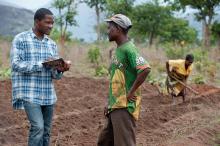Land Library
Bienvenue dans la bibliothèque du Land Portal. Explorez notre vaste collection de ressources en libre accès (plus de 74 000), comprenant des rapports, des articles scientifiques, des articles de recherche, des publications évaluées par des pairs, des documents juridiques, des vidéos et bien plus encore.
/ library resources
Showing items 10 through 18 of 366.This booklet reveals that women only got 103,043 titles representing 10.3 percent, while men got 865,095 titles representing 86.5 percent of the total. The glaring disparity is made clear when looked at against the actual land sizes and titled for women against men.
Land is the foundation of all human activities both social and economic. This is particularly so in agrarian economies such as Kenya. In these economies women are central to economic production in agriculture and livestock sectors.
Implementing Constitutional Land Provisions Now to Enable More Women to Own Land. March 8 is celebrated as the International Women’s Day – an event that celebrates women’s achievements on many scores ranging from the political to the social, and at the same time calling for gender equality.
The Kilimanjaro Initiative is a rural women’s mobilisation from across Africa towards an iconic moment at the foot of Mt Kilimanjaro in October 2016.
The Rural Women’s Land Rights Charter of Kenya is a bold expression of the concerns/ issues and their aspirations of women living in rural areas on land matters.
Land and associated property is a major source of individuals’ identity and livelihood.
It is widely accepted among economists and policy-makers that secure and well-defined land property rights are integral to poverty alleviation and economic prosperity. But how do legal systems, land tenure and economic development really relate to one another?
Access to land is key to achieving food security, poverty alleviation, social equity and environmental protection. A brief insight in land governance-related principles and policies of the German development assistance.
Following the end of apartheid, South Africa’s government set itself ambitious goals with a planned land reform. However, there have since been barely any changes in the country’s agricultural structure, and the positive impacts that were hoped for on rural livelihoods have hardly materialised.








